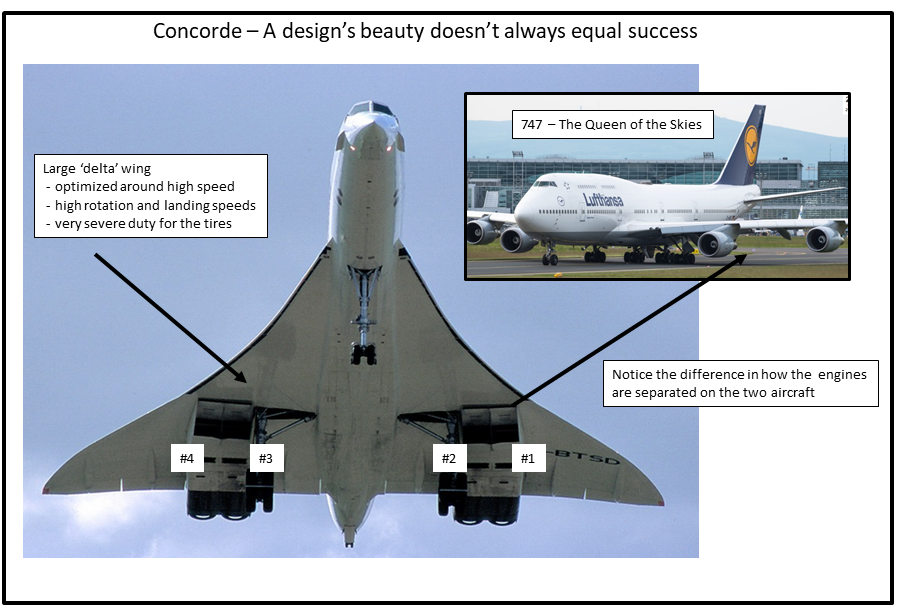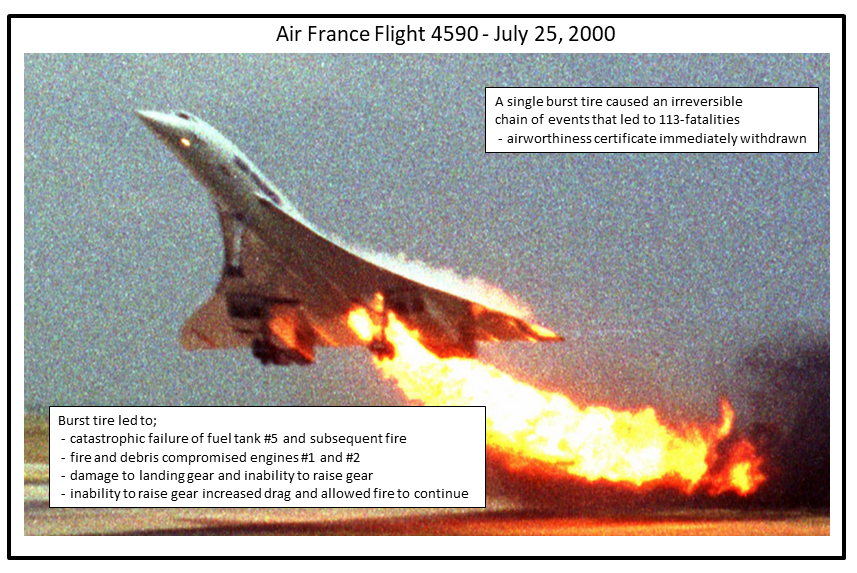The Fed's Airworthiness Certificate Should be Withdrawn
SUMMARY:
- Before an aircraft can be used commercially, it must receive an airworthiness certificate. The certificate is the plane's license to operate.
- Occasionally, a plane's airworthiness certificate will be revoked. This is exactly what happened with the Concorde.
- After the Concorde was placed in service a fatal flaw was discovered; an expected circumstance - a burst tire - could lead to an unrecoverable, irreversible chain of events ending in a fatal accident.
- When the Fed was founded, we were promised a 'passive' central that would only react to the market as a 'lender of last resort.'
- Instead of a passive central bank, the Fed actively intervened in markets and the economy, and attempted to direct both to desired outcomes.
- This 'active' Federal Reserve suffers from a fatal flaw just like the Concorde. The Fed's fatal flaw is it it places an enormous amount of unbridled power in the hands of fallible human beings who will inevitably make mistakes.
- The Fed's fatal flaw has been sparking economic accidents since the Great Depression and its 'license to operate' needs to be revoked in the same way the Concorde's was.
DISCUSSION:
On July 25, 2000, Air France Flight 4590 crashed after attempting to depart Charles de Gaulle Airport. All 109 passengers and crew were killed and four people perished on the ground. As a result of the investigation into the accident it became clear that the Concorde - her breathtaking beauty and elegance notwithstanding - suffered from a fatal flaw. Specifically, an event which could be expected to occur - a burst tire - could lead to an unrecoverable and irreversible chain of events ending with the loss of the aircraft and everyone on board.
Rather than going into an exhaustive description of the Concorde's design and the details of the investigation, the two lists below provides sufficient understanding of the decisions and compromises that drove the plane's design and made it prone to the type of accident she suffered in July 2000.
CONCORDE DESIGN BACKGROUND
- While the Concorde uses four engines, the engine layout is very different than it is on other four engine aircraft. Concorde's engines are arranged in two pair of two engines each. In contrast, other four engine aircraft, like the 747, have the engines separated from each other. See Figure 1.
- Because of the engine layout, aviation authorities wanted to assess the Concorde as a two engine aircraft, not a four engine aircraft. Their argument was a failure of one engine could easily compromise the performance of the engine immediately adjacent to it. A two-engine designation would require the Concorde to be able to takeoff with just two engines instead of three.
- Concorde's designers 'armored' each engine nacelle and claimed this would protect a running engine from the failure of its 'sister' engine' immediately adjacent to it.
- Not surprisingly, the aircraft's design was optimized to perform best at supersonic speeds. The most conspicuous feature of this design optimization was the Concorde's delta wing. See Figure 1.
- The delta wing wasn't nearly as efficient at takeoff and landing. As a result, the Concorde needed much more speed to 'rotate' and become airborne than other aircraft. For example, a 747 - a much larger aircraft with a takeoff weight that could easily exceed 800,000-lbs - rotates at 150-knots. The Concorde, with a maximum takeoff weight half that of a 747 - needs an airspeed of 200-knots to be come airborne. (1)
- The Concorde's higher takeoff - and landing - speeds put an enormous strain on the aircraft's tires. Over its operating life, Concorde suffered fifty-seven tire burst incidents with twelve of these incidents causing structural damage and six leading to damage to the fuel tanks.
FIGURE 1

CHAIN of EVENTS - JULY 25, 2000
- The plane was close to its maximum takeoff weight and completely full of fuel. (95-tons of fuel, almost one-half the aircraft's take-off weight, was on-board.) As was typically the case for Concorde, there was roughly one-ton of fuel per passenger!
- About 35-seconds into the takeoff, Concorde achieved V1 - 150-knots. 'V1' is the speed above which the aircrew must be committed to a takeoff. An attempt to stop the aircraft on the ground at a speed above V1 will cause a disastrous runway overrun.
- A few seconds after achieving V1, Concorde ran over metal debris on the runway and suffered a tire burst.
- A piece of tire debris struck fuel tank #5, immediately adjacent to engines #1 and #2. The debris struck Concorde with an enormous amount of force and caused a buckling of the fuel tank. Because the tank was completely full, the buckling of the tank produced a large shock wave inside the tank. (If you have ever heard your water pipes rattle after turning on the washing machine, this is the exact same mechanism.) Tank #5 then ruptured from the inside out.
- The tire debris likely cut through some wiring, and the combination of the exposed wires and the large leak of fuel from tank #5 led to a large fire on the left side of the aircraft.
- The resulting fire compromised the output of both engines on the left side of the aircraft. (Recall the discussion above comparing how Concorde's four engines were arranged compared to other four engine aircraft.)
- Because the aircraft was traveling at a speed well in excess of V1, the pilot was committed to getting Concorde airborne. However, with just two operating engines, Concorde struggled to become airborne.
- Once airborne, the aircrew immediately attempted to increase Concorde's speed. They attempted to raise the landing gear to reduce the plane's drag but were unable to do so. (The burst tire damaged the landing gear and made it impossible to retract.)
- With just two engines generating power, the plane's gear stuck in the down position and close to her maximum takeoff weight, Concorde was doomed.
- Another important aspect of the gear remaining in the down position is it likely allowed the fire to continue to burn. In the down position, the landing gear created turbulent mixing between the the air and leaking fuel and allowed the fire to continue to burn. With the gear in the 'up' position, most experts believe the fire would have been snuffed out by the unabated flow of air.
- As the fire continued to burn, it began to consume a portion of Concorde's left wing. As the wing suffered more and more damage, the left side wing generated less and less lift. The pilot attempted to counteract this by rolling Concorde to the right.
- It was no use and Concorde rolled left through an angle in excess of 100-degrees before crashing.
- See Figure 2 for additional details.
FIGURE 2:

A mere 121-seconds elapsed between the start of Concorde's takeoff roll and her crash into the earth. Once the tire burst, there was nothing the aircrew could do to the save the plane and the people on-board. As a result of the fact that a simple tire failure could lead to the loss of the aircraft, Concorde's airworthiness certificate was revoked.
THE FEDERAL RESERVE'S 'LICENSE TO OPERATE'
The Federal Reserve suffers from a fatal flaw of its own and needs its certificate to operate to be withdrawn. When the Fed was founded, we were promised a 'passive' central bank that would not attempt to interfere in the market. Instead, the Fed would simply serve as a 'lender of last resort' and, in doing so, prevent an unnecessary money panic.
The Fed we were promised can be summarized in "Bagehot's dictum." Walter Bagehot summarized good central banking practice as "in a crisis a central bank can lend freely but only against good collateral and only at high rates of interest." The concept was solvent firms - with sound, wealth producing assets - would be willing to borrow money, even at high rates, to manage a temporary shortfall of cash or temporary economic downturn. In contrast, unsound, speculative businesses - whose unsoundness was starting to manifest itself in poor business performance - would be unwilling to borrow money at these same high rates. By only providing credit to sound businesses, Bagehot's dictum helps to ensure profitable businesses have sufficient access to credit without giving rise to a false, speculative boom built on cheap money.
However, the passive Fed we were promised isn't the Fed we received. From the beginning the Fed attempted to micromanage the economy and direct it towards an outcome it was, (somehow), uniquely able to judge best. Basically, the Fed assumed a role it was never given - that of central planner. In its role as central planner, the Fed played an enormous role in causing the Great Depression, the ruinous inflation of the 1970s, the tech bubble, the housing bubble, today's everything bubble and today's unprecedented concentration of wealth. That the Fed would be the source of so much economic chaos as it attempted to centrally plan and micro-manage the economy is unsurprising. A system of central planning is based on fallible human beings not making mistakes, and is thus doomed to failure; just like the Concorde. Because of its fatal flaw, the aviation authorities had the good sense to ground the Concorde. Its long past the time for today's activist, central planning Fed to have its 'license to operate' revoked.
Peter Schmidt
October 31, 2021
Sugar Land, TX
PS - As always, if you like what you read, please consider registering with the site. It just takes an e-mail address, and I don't share this e-mail address with anyone. The more people who register with the site, the better case I can make to a publisher to press on with publishing my book! Registering with the site will also give you access to the entire Confederacy of Dunces list as well as the Financial Crisis timeline. Both of these documents are a treasure trove of information on the crisis and the long-running problems that led to it.
ENDNOTES:
1. A 'knot' is a nautical mile, and is equivalent to approximately 1.15-miles. So, a speed of 200-knots is roughly 230-mph.

